Which river is known as Bhagirathi River?

The Bhagirathi River is one of the main tributaries of the Ganges River in northern India. It is named after the legendary King Bhagirath, who is associated with bringing the Ganges River to the Earth.
The Bhagirathi River originates from the Gangotri Glacier in the state of Uttarakhand. It is one of the headstreams of the Ganges and is considered the true source of the Ganges. The river flows for about 205 kilometers (127 miles) before it meets with the Alaknanda River at Devprayag, forming the Ganges River.
The Ganges, known as the Ganga, continues to flow downstream from the confluence of the Bhagirathi and Alaknanda rivers, ultimately becoming one of the most sacred and important rivers in India. The Bhagirathi River is revered for its cultural and religious significance, and the entire Ganges River system holds great importance in Hinduism.
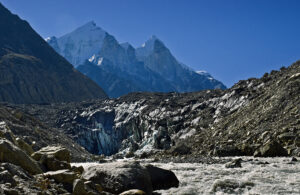
Gangotri Glacier: The Bhagirathi River originates from the Gangotri Glacier, which is situated at an altitude of about 4,100 meters (13,500 feet) in the Garhwal Himalayas. Gangotri Glacier is one of the largest glaciers in the Himalayas and serves as the starting point for the Bhagirathi, making it a significant source for the Ganges River.
The Gangotri Glacier, nestled in the Garhwal Himalayas of Uttarakhand, India, stands as a majestic emblem of spiritual and natural significance. Extending over approximately 30 kilometers, it is the primary source of the Bhagirathi River, a crucial tributary that ultimately contributes to the sacred Ganges. At an altitude of about 4,000 meters, the glacier’s snout, known as Gaumukh, resembles a cow’s mouth, giving it a distinctive appearance. Gangotri Glacier holds a revered place in Hinduism, forming a key element of the Char Dham pilgrimage. Pilgrims embark on a challenging trek to Gangotri town to seek the blessings of Goddess Ganga at the Gangotri Temple.
Beyond its religious importance, the glacier serves as a scientific marvel, attracting researchers studying glacial dynamics and the impact of climate change on the Himalayan region. The trek to Gaumukh offers adventurers a panoramic view of the breathtaking Himalayan landscape, making Gangotri Glacier a destination that seamlessly blends spirituality, natural beauty, and scientific curiosity.
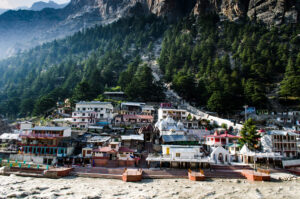
Gangotri Town: The town of Gangotri, located in Uttarakhand, is an important pilgrimage site for Hindus. It is situated on the banks of the Bhagirathi River and is considered one of the Char Dham pilgrimage destinations.
Nestled in the breathtaking landscapes of the Garhwal Himalayas in Uttarakhand, India, Gangotri town stands as a sacred haven and a gateway to spiritual enlightenment. Perched at an altitude of approximately 3,100 meters, this town is revered as one of the Char Dham pilgrimage sites, drawing devotees from far and wide to embark on a soul-stirring journey.
At its heart lies the Gangotri Temple, dedicated to Goddess Ganga, where pilgrims converge during the summer months to seek blessings and witness the divine source of the Bhagirathi River, which originates from the nearby Gangotri Glacier.
The town itself, with its serene ambiance, is not only a religious center but also a base for trekkers exploring the majestic Himalayan trails. The Ganga Aarti, performed on the banks of the Bhagirathi River, adds a spiritual charm, resonating with the chants and hymns that echo through the town. Gangotri serves as a summer retreat, offering respite from the heat of the plains, and its proximity to the Gangotri Glacier makes it a focal point for both religious pilgrimage and adventure seekers.
Accessible by road from Uttarkashi, Gangotri provides a rare blend of cultural richness, natural beauty, and tranquility. The town’s significance transcends its geographical boundaries, symbolizing the convergence of spirituality, pristine landscapes, and the enduring traditions that have shaped the cultural tapestry of the Indian subcontinent. In Gangotri, one discovers not just a town but a sanctuary where the Himalayan air carries whispers of ancient legends, and the flowing waters bear the essence of divine blessings.

Devprayag Confluence: At Devprayag, the Bhagirathi River meets the Alaknanda River, and together they form the Ganges. Devprayag is a sacred town where the confluence takes place, and it is also a significant pilgrimage site.
Devprayag, a town nestled in the Himalayan state of Uttarakhand, India, holds a unique and sacred distinction as the divine confluence of the Alaknanda and Bhagirathi rivers, giving birth to the sacred Ganges River. The town, situated at an elevation of around 830 meters, is a significant pilgrimage site and a crucial landmark in the Char Dham Yatra, drawing spiritual seekers, pilgrims, and nature enthusiasts alike.
The meeting point of the Alaknanda and Bhagirathi rivers is marked by a spectacular spectacle of swirling waters, creating a harmonious blend of two powerful streams. Devprayag is home to the Raghunathji Temple, dedicated to Lord Rama, and the Chandrabadani Temple, perched atop a hill, offering panoramic views of the confluence below.
The confluence is not merely a geographical phenomenon; it holds deep cultural and spiritual significance. Devotees believe that bathing in the sacred waters at Devprayag cleanses one of sins and paves the way for spiritual redemption. The town resonates with the chants of priests, the aroma of incense, and the devotion of pilgrims who gather to witness and partake in the divine energy of this sacred junction.
Beyond its religious aura, Devprayag invites travelers to immerse themselves in the natural beauty that surrounds the confluence. The verdant hills, the gushing rivers, and the tranquil ambiance create an atmosphere that beckons reflection and introspection.
Accessible by road, Devprayag stands as a testament to the confluence of nature, spirituality, and cultural heritage, offering a unique pilgrimage experience where the meeting of rivers symbolizes the unity of forces, the flow of time, and the eternal sanctity of the Ganges.
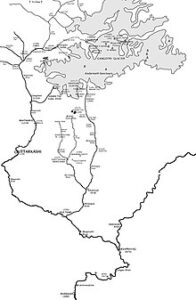
Bhagirathi River Basin: The Bhagirathi River basin encompasses a diverse range of landscapes, from the high-altitude regions near the glacier to the lower foothills and plains downstream. This basin supports various ecosystems and is vital for agriculture, as it provides water for irrigation.
The Bhagirathi River Basin, located in the Indian state of Uttarakhand, unfolds as a pristine and vital region in the lap of the Himalayas. Named after the legendary King Bhagirath, the basin encompasses a network of rivers, streams, and tributaries, ultimately giving rise to the sacred Ganges River at Devprayag. The Bhagirathi River, originating from the Gangotri Glacier, is the primary contributor to this basin.
The basin not only holds immense ecological significance but also plays a crucial role in India’s cultural and spiritual heritage. The town of Gangotri, perched at the origin of the Bhagirathi River, is a revered pilgrimage site where devotees embark on the Char Dham Yatra, seeking the blessings of Goddess Ganga. The glacier-fed waters of the Bhagirathi traverse through picturesque landscapes, sustaining diverse ecosystems and providing crucial water resources to downstream regions.
Moreover, the Bhagirathi River Basin is marked by several towns and villages that have grown alongside its flow, with settlements like Uttarkashi and Devprayag serving as cultural and historical nodes. These areas not only thrive on the river’s resources but also hold deep-rooted spiritual significance as they are integral stops on the pilgrimage routes.
The Bhagirathi River Basin is not just a geographical expanse; it is a living testament to the intricate interplay between nature and culture. The pristine beauty of the region, the sacredness associated with its rivers, and the cultural practices that have evolved alongside the flowing waters contribute to the rich tapestry of India’s heritage. As the Bhagirathi winds its way through this basin, it weaves a narrative of ecological importance, cultural traditions, and the eternal spiritual connection between the Himalayas and the plains.
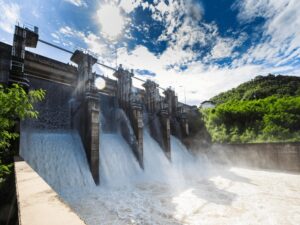
Hydropower Projects: The Bhagirathi River, like many Himalayan rivers, has been harnessed for hydropower generation. Several dams and hydroelectric projects are situated along its course, contributing to the region’s energy needs.
The Bhagirathi River Basin in Uttarakhand, India, has witnessed the development of several hydropower projects, harnessing the potential of its cascading rivers for electricity generation. These projects contribute significantly to the region’s energy needs and play a crucial role in India’s efforts to diversify its energy mix.
Among the notable hydropower projects in the Bhagirathi River Basin, the Tehri Dam and Hydroelectric Complex stands out as a flagship endeavor. Located near Tehri town, it is one of the largest hydroelectric projects in Asia, with an impressive capacity to generate over 1,000 megawatts of electricity. The dam not only provides clean energy but also serves multiple purposes, including irrigation, flood control, and drinking water supply.
Other projects like the Maneri Bhali Stage I and II hydropower plants, the Bhilangana Hydroelectric Project, and the Koteshwar Dam contribute substantially to the harnessing of the Bhagirathi’s hydropower potential. While these projects have undoubtedly played a crucial role in addressing the energy needs of the region and the nation, they have also raised environmental concerns. The alteration of river flow, impact on aquatic ecosystems, and concerns about displacement and ecological balance have sparked debates around the sustainability of such projects.

In balancing the imperative for energy development and environmental conservation, the hydropower projects in the Bhagirathi River Basin underscore the complex interplay between economic progress and ecological preservation. As India continues to pursue a sustainable energy future, the Bhagirathi River and its tributaries remain both a source of power and a focal point for discussions on responsible and environmentally conscious energy development.
The Bhagirathi River, one of the primary headstreams of the Ganges, originates from the Gangotri Glacier in the Garhwal Himalayas of Uttarakhand. Its journey through the rugged terrains of the state is not only marked by awe-inspiring natural beauty but also by its immense cultural and religious significance. Gangotri, the source of the Bhagirathi, is a revered pilgrimage site for Hindus and the starting point for the sacred Char Dham Yatra.
As the Bhagirathi River flows downstream, it passes through towns such as Uttarkashi and Devprayag, where it meets the Alaknanda River to form the Ganges. Devprayag holds particular importance as the confluence site, and its Sangam witnesses numerous rituals and ceremonies. The Bhagirathi River, named after the legendary King Bhagirath, who is credited with bringing the divine Ganges to Earth, is thus entwined with mythological narratives and spiritual practices.
Apart from its religious role, the Bhagirathi River is vital for the region’s irrigation, supporting agriculture along its banks. The river’s waters are also harnessed for hydropower generation, contributing to the energy needs of Uttarakhand and beyond. While the Bhagirathi embodies the cultural and historical heritage of the region, it faces challenges such as environmental degradation and the impacts of development projects.
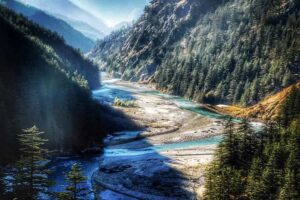
Efforts to preserve the Bhagirathi’s natural integrity while respecting its cultural significance are crucial for maintaining the delicate balance between tradition and sustainability in Uttarakhand. The Bhagirathi River, with its majestic course and cultural relevance, stands as a testament to the intricate connection between the spiritual, ecological, and socio-economic facets of the region.
The Bhagirathi River, originating from the Gangotri Glacier, is not just a geographical entity but a cultural and historical lifeline for Uttarakhand. Its pristine waters are believed to hold divine attributes, and the Char Dham Yatra, encompassing Gangotri, Yamunotri, Kedarnath, and Badrinath, is considered a sacred pilgrimage circuit for Hindus. The river’s flow through the Himalayan landscapes adds to its spiritual aura, attracting not only pilgrims but also nature enthusiasts and adventure seekers.
The Bhagirathi’s significance extends to the socio-economic domain as well. The fertile plains along its course are vital for agriculture, supporting the cultivation of crops that sustain local communities. Furthermore, the river’s swift currents are harnessed for hydroelectric power generation, contributing to the region’s energy needs.
However, the Bhagirathi, like many rivers in the region, faces challenges such as pollution, deforestation, and the impacts of infrastructure development. Balancing the ecological health of the Bhagirathi River with the developmental needs of the region is a delicate task. Conservation efforts, sustainable practices, and community involvement are essential to ensure the continued vitality of the Bhagirathi River, preserving its cultural and ecological importance for future generations. In essence, the Bhagirathi encapsulates the complex interplay between spirituality, environment, and sustainable development in the Himalayan state of Uttarakhand.
The Bhagirathi River holds a unique place in the heart of Uttarakhand, not only as a sacred waterway and a source of livelihood but also as a testament to the region’s geological and glacial history. Flowing through the Gangotri Valley, the Bhagirathi River is surrounded by towering peaks, pristine glaciers, and alpine meadows, creating a landscape of exceptional natural beauty. The river’s waters, originating from the melting Gangotri Glacier, bear witness to the millennia-long process of ice formation, serving as a link between the region’s ancient geological past and the present.
Beyond its spiritual and scenic importance, the Bhagirathi River plays a cr
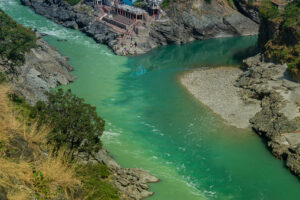
ucial role in shaping the local ecosystem. The river supports a diverse array of flora and fauna, contributing to the region’s biodiversity. The forests and habitats along its banks are home to various species, making it an ecologically significant corridor in the Himalayas.
However, the Bhagirathi River faces environmental challenges, including the impacts of climate change on glacial melt and potential alterations in water flow patterns. Conservation efforts, coupled with sustainable land-use practices, are crucial to ensuring the long-term health of the river and its surrounding ecosystems.
In summary, the Bhagirathi River in Uttarakhand is not only a symbol of spiritual reverence and economic utility but also a living chronicle of the region’s geological evolution and ecological richness. Preserving the Bhagirathi River is not just a local concern; it is a commitment to safeguarding the natural and cultural heritage of Uttarakhand for generations to come.
1. Is Bhagirathi and Ganga same?
The Bhagirathi River and the Ganga (or Ganges) River are often considered to be the same river, although there is a slight distinction between the two. The Bhagirathi is one of the two main headstreams of the Ganges, with the other being the Alaknanda River. The Bhagirathi originates from the Gangotri Glacier in the Indian state of Uttarakhand and flows for approximately 205 kilometers (127 miles) before it meets the Alaknanda River at Devprayag to form the Ganges River.
Once the Bhagirathi and Alaknanda converge at Devprayag, the river downstream is known as the Ganga or Ganges. The Ganges River then continues its journey through various states of India, including Uttarakhand, Uttar Pradesh, Bihar, and West Bengal, before ultimately emptying into the Bay of Bengal.
2. Where does Bhagirathi River start and end?
The Bhagirathi River originates from the Gangotri Glacier, which is located at Gaumukh in the Indian state of Uttarakhand. Gaumukh is approximately 19 kilometers (12 miles) from the town of Gangotri. From its source at Gaumukh, the Bhagirathi River flows for approximately 205 kilometers (127 miles) through the rugged terrain of the Himalayas.
The Bhagirathi River meets the Alaknanda River at Devprayag in Uttarakhand, where they converge to form the Ganges River. Devprayag is considered a sacred confluence point, and from this point onward, the river is known as the Ganga or Ganges. Therefore, the Bhagirathi River effectively ends at Devprayag, where it merges with the Alaknanda to form the Ganges.

